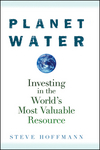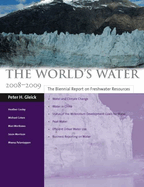Planet Water: Investing in the World’s Most Valuable Resource (2009)
By Steve Hoffmann

The United Nations reports that 4,500 children die each day of preventable waterborne diseases as a result of poor drinking water quality and lack of sanitation services. Statistics like these drive the Millennium Development Goal (MDG) that aims to reduce the number of people without access to clean water in half by 2015. According to Hoffman, these are also the kind of statistics that should tickle investors interest in the soon to be ridiculously profitable world of water. Hoffman scoffs at the dated simplicity of Smith’s diamond-water paradox that asks, “Why is it that diamonds, which have limited practical use, command a higher price than water, which is a prerequisite for life?” Hoffman argues that this paradox and the economics theory of marginal utility will be far less applicable to water as it becomes further commoditized and less readily available. The price of water (which is artificially low now and has been historically due to government subsidies) will rise due to global quantity and quality issues. He reminds investors, “there are no substitutes for water” (Introduction, para 11).
Hoffmann is fully informed on all things water. In a demonstration of his knowledge of water science, he explains how a single water molecule is formed and what chemical bonds are responsible for its unique properties and describes how properties like water’s polarity, high surface tension and specific heat directly translate into investment opportunities.
Hoffman is less convincing in his analysis of how social, political and geographic variables can influence water politics. Hoffman makes wide, sweeping statements like, “the lack of water, of acceptable quality and in sufficient quantity, is a major factor in poverty, food insecurity, human disease, economic development, and, ultimately, geopolitical conflict (Ch. 1, para. 16). Although eloquently written, Hoffman never really does more than recognize the connection between water business and quality of life issues or quote from statistics generated by diplomatic and not-for-profit organizations.
This is not to say that Hoffman is unconcerned with the human condition. He simply sees him ideas about water as far more practical, realistic and sustainable than your average headline-seeking activist, blinded by principal. “If water is vital and, as such, a public good, then the implication is that governments must intervene to provide equitable distribution. However, if it is truly a commodity, the implication is that market forces alone can readily provide optimal allocation (Ch. 3. Para. 1). Hoffman falls into the camp of the latter.
Hoffman’s writing is concise and informative and only occasionally dry. He does, however, offer a cold analysis of money-making ventures that directly impact the quality of life of some of the planet’s poorest people. For a reader with the ability to separate the human aspect from Hoffmann’s suggested investments, this book has the potential to inform water-novice investors on how to make heaps of money in the fast growing industry of water. However, he leaves his socially conscious reader always waiting for an explanation on how investments, in what Hoffmann sees as the most valuable of commodity, will be socially beneficial in ways that could help thwart the preventable deaths of 4,500 children each day.







